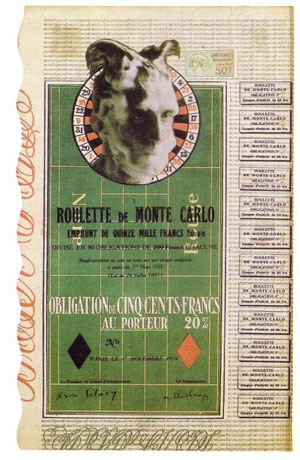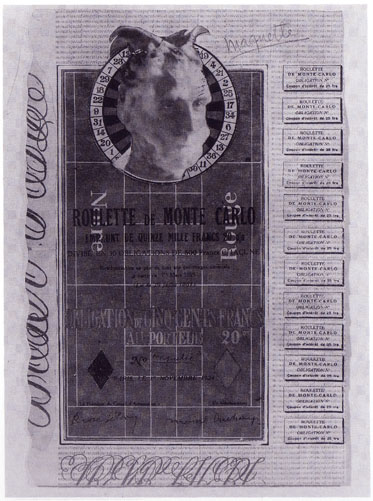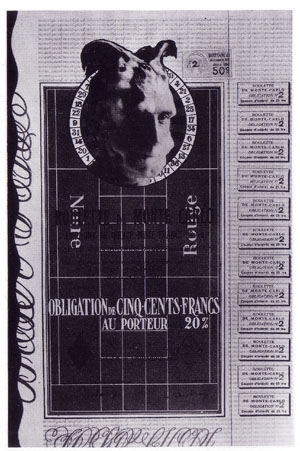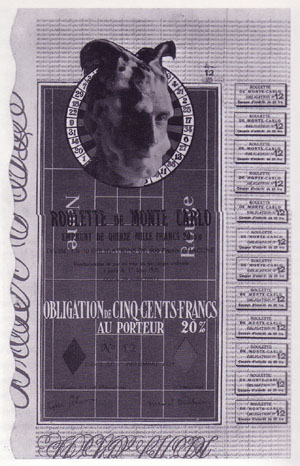
Monte Carlo Bond
or
Obligations pour la roulette de Monte Carlo
 |
| Original version, 1924 |
|
Original Version:
1924, Paris |
A parody of a financial document in a system for playing roulette, this Readymade revolves around the idea of monetary transactions. Giving himself the position of Administrator, Marcel Duchamp conceived of a joint stock company designed to raise 15,000 francs and thus "break the bank in Monte Carlo" (Sheets 38). It was to be divided into 30 numbered bonds for which Duchamp asked 500 francs each. However, less than eight were actually assembled.
Monte Carlo Bond incorporates Duchamp's interest in linguistics and punning. The nonsensical pun "moustiques domestiques demistock" (translating as "domestic mosquitoes half stock") is repeated continuously at the top of the piece.
 |
| Maquette |
This Readymade's true artist is disputable, drawing on Duchamp's interest in questioning the traditional role of the artist. The piece itself is clearly Duchamp's, yet the photo of the artist was taken by his close friend and confidante Man Ray. Taking this issue a step further, the two signatures on the piece together illustrate a further complication: "Rrose Selavy" is printed in ink on the lower left while "Marcel Duchamp" simultaneously appears on the lower right. As a type of collaboration between Duchamp and his transvestite alter ego, Monte Carlo Bond stands as a gendered Readymade. Schwarz provides one type of sexual interpretation, noting Freud's theory that gambling is an activity as frustrating as onanism: "the passion to play is an equivalent of the old compulsion to masturbate" (704).
The lithograph's portrait of Duchamp by Man Ray illustrate's Duchamp's interest in humor. In this comical portrait, Marcel is literally "transformed through shaving cream" into what Joselit terms a "chimerical figure, perhaps resembling a faun or devil..." (101). There appears so be some disagreement over the technicalities of this intriguing portrait transposed onto a roulette wheel. Schwarz calls the substance in Duchamp's hair "soapsuds" versus others' claims to it being shaving cream (703). However, all agree that the sculpting of the artist's hair produces a rather ridiculous result, no matter what the substance technically is. When discussing another similar photo taken at the same time by Man Ray, Sheets comments that Duchamp appears "with his hair sculpted into a rooster's pomp" (38).
 |
| Original version (one in series), 1924 |
Perhaps in an effort to make the bond appear legitimate, Duchamp printed the following extracts from the Company Statutes on the reverse side:
| "Extracts from the Company Statutes Clause No. 1. The aims of the company are: 1. Exploitation of roulette in Monte Carlo under the following conditions. 2. Exploitation of Trente-et-Quarante and other mines on the Cote Azur, as may be decided by the Board of Directors. Clause No. 2. The annual income is derived from a cumulative system which is experimentally based on one hundred thousand rolls of the ball; the system is the exclusive property of the Board of Directors.
The application of this system to simple chance is such that a dividend of 20% is allowed. Clause No. 3. The Company shall be entitled, should the shareholders to declare, to buy back all or part of the shares issued, not later than one month after the dare of the decision. Clause No. 4. Payment of dividends shall take place on March 1 each year or on a twice yearly basis, in accordance with the wished of the shareholders" (Schwarz 703). |
 |
| Replica, 1941 |
In the end, the artist's elaborate financial system did not work, and Duchamp eventually admitted that he never really did win anything (Schwarz 704). In classic Duchampian style, the idea of the system, not its physical manifestation (in this case a monetary profit), is what stands as important in the end.
Replicas:
1) Maquette for Monte Carlo Bond
Kunsthaus Zurich
Inscribed in in pencil "maquette"
2) 1938, Paris
Color reproduction. Made for Siecle (Paris), no. 4 (Christmas 1938)
2,000 copies in print
3) 1941, Paris
Color reproduction.
Made for inclusion in The Box in a Valise